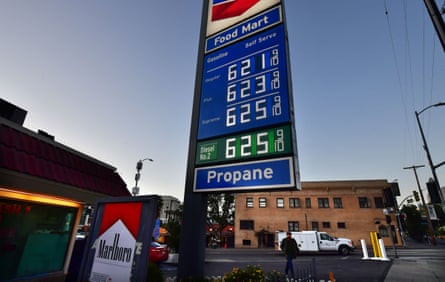“I will not pretend this will be painless,” Joe Biden warned Americans before Russia’s invasion of Ukraine. And as the war disrupts already hard-hit international trade, US consumers are likely to soon see just how painful the consequences of the conflict will be in the US.
Inflation is already at a 40-year high in the US and, depending on the length and depth of Russia’s war, any further disruption could cause prices to rise at the pump and perhaps on store shelves.
The invasion could also have potential long-term implications for Biden’s green energy transition since a significant amount of key metals are mined and produced there, including nickel, palladium and aluminum.
While US-Russian trade is relatively small, the country is home to a broad range of natural resources, from crude oil to wheat. Prices for those natural resources soared following Russia’s incursion, although most are off the highs they hit when the invasion began.
On Thursday, Nymex futures prices for the most active crude oil and gasoline contracts – an indication of the future cost of buying oil – spiked to their highest levels since July 2014, with the US benchmark West Texas Intermediate briefly touching $100 a barrel and reformulated gasoline prices rising as high as $3.07 a gallon.
Wheat prices continued their climb on Friday as fighting continued. Chicago Board of Trade wheat prices were trending higher before Russia’s invasion, but spiked higher still on Thursday and Friday, rising at one point to their highest level since April 2008.
Russia and Ukraine collectively are known as Europe’s breadbasket, responsible for 30% of the world’s export supply of wheat. Much of that is shipped through the Black Sea to the Middle East and African countries, which take advantage of lower prices and shipping costs from the region.
Uncertainty regarding Russian president Vladimir Putin’s intention are inflating commodity prices across the board, but wheat prices also remain high because of significantly tight global supplies. Dry weather conditions in the US and in other top-growing regions globally limited harvests, and the Covid pandemic increased demand while snarling logistics. In addition to poor weather, many US farmers preferred to plant corn and soya beans versus wheat because of persistently low prices, with sowings last year at 100-year lows.
Low global wheat stocks will make it harder for other countries such as the US, Canada and Australia to cover a possible global shortfall out of Ukraine, “and now you have a war in that area. Where this (prices) will go is a major, major question mark,” said Sean Lusk, vice-president of the commercial hedging division for Walsh Trading.

With inflation up 7.5% in January over last year, higher food and energy costs are already the two biggest concerns consumers have right now, said Rob Haworth, senior investment strategy director at US Bank Wealth Management. Food prices rose 7% year-over-year in the January consumer prices index report, while energy costs gained 27%.
The ramifications of Russia’s invasion are most likely to appear first at the gas station. Further increases in energy costs come as the world is already dealing with critically low energy inventories. Jay Hatfield, portfolio manager at Infrastructure Capital Advisors, says the current futures prices for gasoline could translate to $4 a gallon for retail prices in a few weeks, up from the current national average of $3.54. “That’s going to be an enormous political problem,” Hatfield said.
US crude oil production is slowly increasing, but it won’t be enough to make inventories rise, said Peter McNally, global sector lead for industrials, materials and energy at consultancy Third Bridge. Part of the US’s problem is refinery capacity, which fell by a 1m-plus barrels a day during the pandemic, limiting how much fuel can be produced. That could be a problem for the summer driving season when demand peaks. “We’ve got a couple months here to see if we can build enough product inventory to meet that demand,” he said.
The Federal Reserve was poised to raise interest rates next month to combat higher inflation, but the Russian conflict adds to the central bank’s problem, Haworth said, which will have to weigh a geopolitical shock with an aggressive attempt to tame inflation.
One long-term implication if the Russian-Ukraine war continues is how commodity producers and end-users grapple with the global push for clean energy investment. Russia is a major nickel miner, a metal used in battery production, and aluminum, used in most industrial products. It also is a top palladium producer, used in catalytic converters. So far, western nations haven’t targeted commodity exports and Russia hasn’t stopped sales. But the commodity experts point out there’s been several years of low capital investment across the complex, which led to reduced inventories, even before Covid messed up supply chains. Building infrastructure, such as new mines, takes years.
Roland Harris, portfolio manager for the commodity index strategy at VanEck, says the energy transition story is going to play out over a number of years, meanwhile, supply issues will take a while to work out. He thinks inflation will be much longer-lasting, whether it’s trade disputes or countries trying to secure their own national resources. That’s going to hit US consumers long-term at a time where prices are already high.
“We’re seeing the end of globalization. Trade friction, countries trying to secure resources, all those things are inflationary,” he said.
